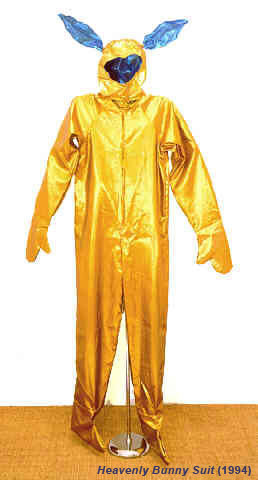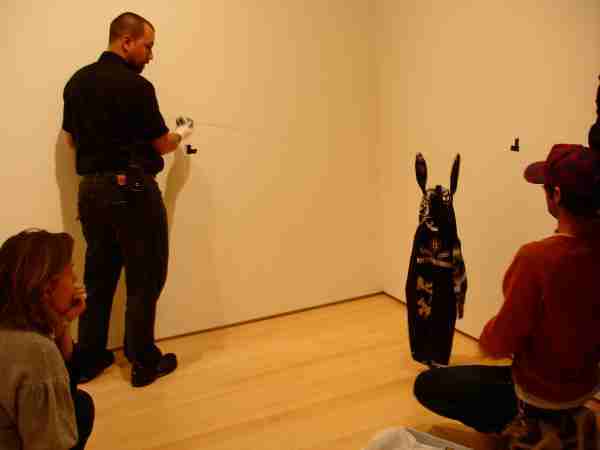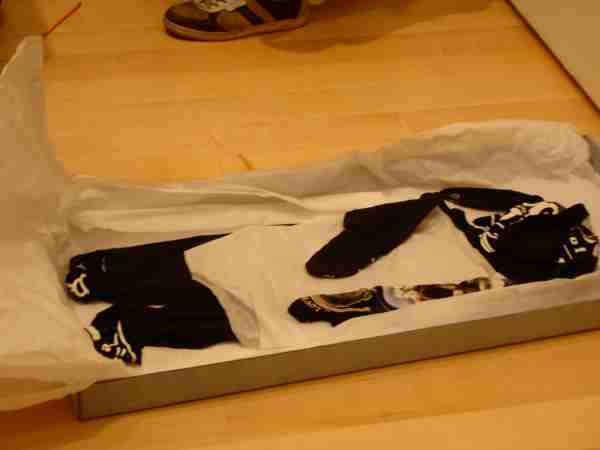Burning Down the House Artist Focus: NAYLAND BLAKE
Curator Maura Reilly installing Nayland Blake’s Untitled, 2003 in the galleries of the Elizabeth A. Sackler Center for Feminist Art with Supervising Maintainer Filippo Gentile, and Art Handler, Jason Grunwald.
New York-based artist and Nayland Blake is without a doubt one of the most compelling artists of his generation, but rarely is his work ever placed in a feminist context. In Burning Down the House: Building a Feminist Art Collection curators Maura Reilly and Nicole Caruth did just that! By situating Blake’s Untitled, 2003, alongside artworks by renowned artists associated with the 1970s feminist art movement, including Carolee Schneeman, Hannah Wilke, and Ana Mendieta, the curators were hoping to suggest that feminist art is not limited to a particular appearance or definition.
I had a chance to talk briefly with Maura Reilly, founding curator of the Elizabeth A. Sackler Center for Feminist Art, and curator of the exhibition Nayland Blake: Behavior, currently on view at Location One through February 14, 2009, to discuss Blake’s work. What follows is a brief segment from our conversation together!
Sarah Giovanniello: Why did you and Nicole choose to include Nayland Blake’s Untitled, 2003, in the exhibition Burning Down the House: Building a Feminist Art Collection?
Maura Reilly: Untitled, 2003 is an outstanding example of the artist’s longstanding interest in the theme of the bunny–a subject that emerged in Blake’s work in the early 1990s and one that resonates with multiple connotations. Blake’s “bunnies” reference complex personal and social narratives about gender, sexual identity, and the artist’s own mixed race heritage. By stitching together the bunny costume out of fabric, a gesture to traditions of Women’s Work and craft, the piece is basically a manifestation of the artist’s take on the complications of gender and masculinity. Subsequently, the vision of the bunny hanging limp and flaccid along a wire cable in the corner of the gallery adds another dimension to this haunting effect. Inscribed on the fabric of the costume are the words “Damirifa, Due, Due!” (Great One, be comforted), a phrase that is used in Ghana as part of West African burial tradition. Blake has explained to me that the bunny also references “Brer Rabbit,” the African American folk hero of the Uncle Remus tales, a character that he uses to explore the complexities of his own biracial mix of African and European heritage.
Untitled, 2003 sits in its storage box awaiting installation.
SG: Why might Nayland Blake’s work fit in to an exhibition about feminism and feminist art?
MR: The artist has mentioned to me that one of the first art experiences to make an impact on him was an installation that was up at the Museum of Modern Art by Nikki deSaint Phalle, who is a very respected artist and feminist. In fact, one of his most famous pieces, The Big One, 2003, a large bunny that resembles the smaller one on view is, in his own words, “directly indebted to [Saint Phalle’s] hybrid of environment and sculpture, and that my body of work, like the work of a number of queer men of my generation, draws two crucial things from the feminist work of the 1970’s: the permission to articulate intimate autobiography as part of a broader social critique, and the understanding that materials and processes can be read as gendered and not as simply neutral entities. I count Lynda Benglis as one of my influences because she made it clear that there wasn’t simply a monolithic abstraction or formalism, but that there are many formalisms and abstractions, and that they have differing political positions. In the early Eighties, when I was attempting to find a way to work that both bore witness to the truth of my sexuality and to my formal training, it was to those notions that I turned.”
This quotation may come off sounding very scholarly, because Blake is himself a curator and an academic, but I think it really upholds one of the key goals of our show, which is to demonstrate that the history of feminist art is and continues to be an ongoing conversation between the past and the present, and one that is always yielding new interpretations.

Nayland Blake Heavenly Bunny Suit, nylon with metal armature, 1994. Courtesy of Location One.
Thanks for the amazing commentary Maura!! Nayland Blake performs a restaging of his well-known 1998 performance piece “Gorge” at Location One tonight! “Gorge” is an hour-long performance during which the artist sits shirtless in front of a table of food, and invites the audience to feed him. Later, Eileen Myles, Brina Thurston, Chris Cochrane, and Lauren Siberman share short performances in response to Blake’s work.
Nayland Blake: Behavior, a 25-year survey of the artist’s work, curated by Maura Reilly, is on view at Location One through February 14, 2009. Check out the artist’s sculpture Untitled, 2003 on view in Burning Down the House: Building a Feminist Art Collection through April 5th (video from the exhibition below).

Sarah Giovanniello is the former Research Assistant at the Elizabeth A. Sackler Center for Feminist Art at the Brooklyn Museum, where she assists the Curator of the Center with exhibitions, a growing permanent collection that includes The Dinner Party by Judy Chicago, public programs, and projects related to feminism, feminist art, and the collection. Since 2008, she has worked on numerous exhibitions, including Kiki Smith: Sojourn, Healing the Wounds of War: The Brooklyn Sanitary Fair of 1864, Ghada Amer: Love Has No End, Reflections on the Electric Mirror: New Feminist Video, and Seductive Subversion: Women Pop Artists, 1958–1968. In 2009, she organized the mounting of Jen DeNike's TWIRL at the Museum for PERFORMA09. She has worked on numerous public programs, her favorites of which include making ourselves visible: a project in feminist space making with artists Liz Linden and Jen Kennedy, and the 2008 Emerging Scholars Feminist Art Symposium, Feminism NOW. As Research Assistant, she manages the Feminist Art Base and posts to the Brooklyn Museum blog on topics related to the Center's programs, projects, and exhibitions. Sarah holds an M.A. in Performance Studies from NYU and a B.A. from Bryn Mawr College.


